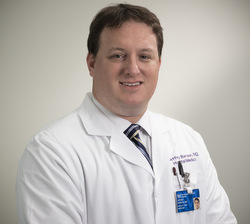
A resident practices central line insertion during a simulation-based training session. Since being introduced in 2006, the program has greatly reduced the number of infections from lines placed by Northwestern residents.
A preventable illness costing hundreds of millions of dollars in annual healthcare costs, central line-associated bloodstream infections (CLABI) have seen an unprecedented decline among Northwestern residents thanks to an innovative, simulation-based training program.
On Tuesday, Jeffrey Barsuk, MD, MS, associate professor in hospital medicine, presented information about the program he developed and implemented with Diane Wayne, MD, Dr. John Sherman Appleman Professor of Medical Education, to a national audience. Hosted by the Association of American Colleges, Barsuk’s “Improving Patient Outcomes for Central Venous Catheter Insertion with Simulation-based Mastery Learning,” webinar offered insight into the residents’ success.
“What we are told is that the intensive care unit (ICU) central line-infection rate from lines placed by our residents is at or near zero since we started this training in 2006,” Barsuk said. “The leadership there believes it is our training that has sustained this effect over the past six-plus years.”
The most recent Centers for Disease Control and Prevention estimates show that 10,000 of the 41,000 patients who acquired CLABIs died while being cared for in U.S. intensive care units.

First published in 2009, Barsuk and Wayne’s training approach brought catheter insertion simulation to second- and third-year residents in the month before their ICU rotation.
“Mastery training is an extreme form of competency-based learning that requires learners to achieve a minimum passing score before their training ends,” Barsuk said. “The bar is set high by an expert panel that determines this minimum passing score.”
Following Barsuk’s presentation, Peter Pronovost, MD, PhD, director of the Armstrong Institute for Patient Safety and Quality at Johns Hopkins Medicine, elaborated on scaling and spreading the training innovation to other academic medical centers.
“It was really nice for me to give a talk with Dr. Pronovost because he is the grandfather of innovation when it comes to reducing central line infections in hospitals,” Barsuk said. “This webinar was a very exciting opportunity to potentially improve patient care nationwide. We have had other opportunities to present this training, but working through an organization like the AAMC provides a unique opportunity for successful dissemination and implementation.”






